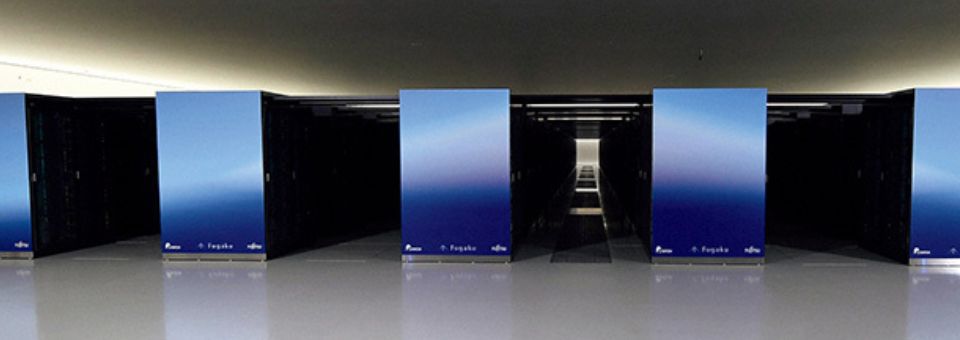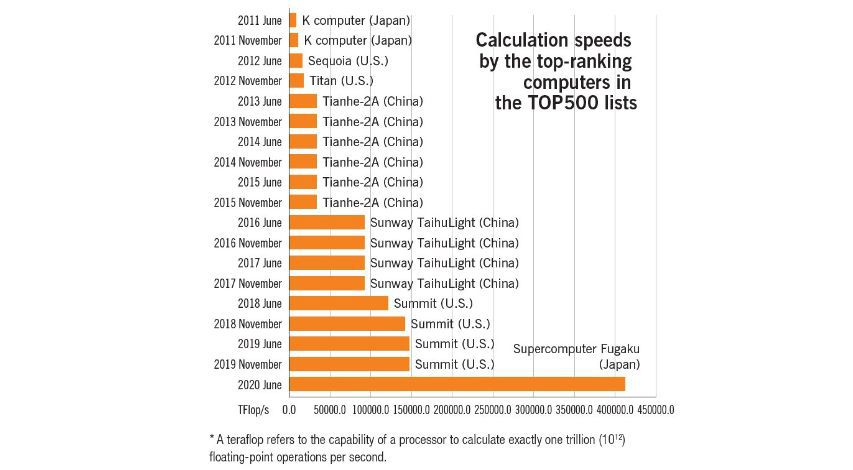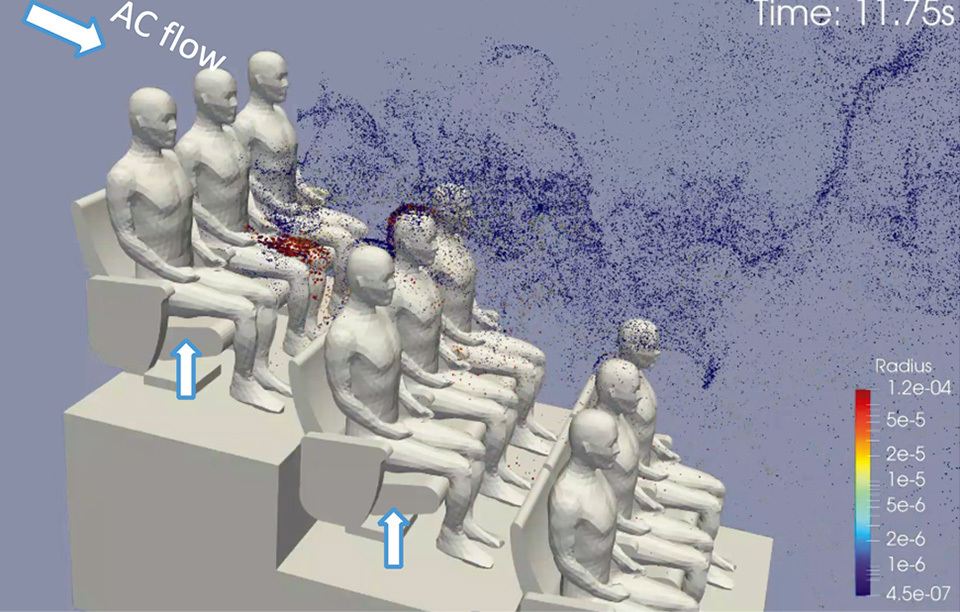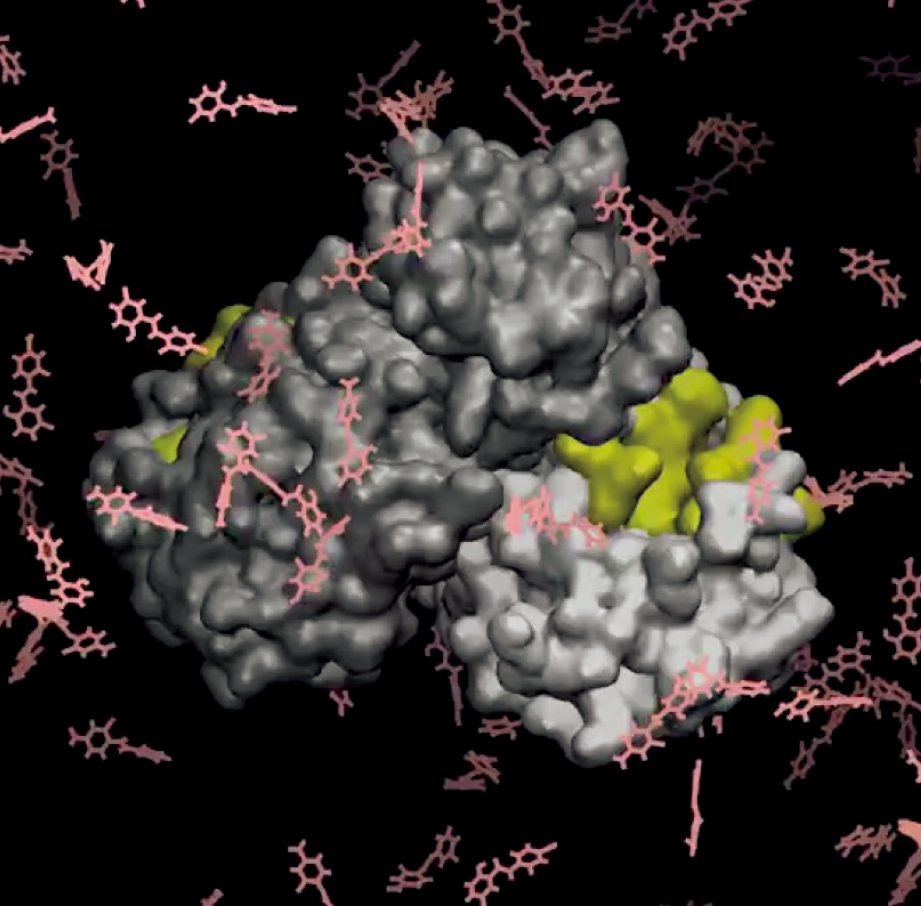 |
Fugaku has claimed top spots in four fields of performance: computing speed, AI, big data, and application performance. In developing Fugaku, Fujitsu and RIKEN aimed to create a highly versatile supercomputer that can solve various social issues.
|
In June 2020, Japan’s supercomputer Fugaku was certified as the fastest computer in the world. Boasting high levels of performance and versatility, it has already achieved positive results in the fight against COVID-19.
The Japanese supercomputer Fugaku has been attracting a great deal of attention for helping combat the ongoing coronavirus pandemic. As the RIKEN Institute and Fujitsu Ltd. jointly started developing it in 2014, Fugaku can be seen as an amalgamation of Japanese technological prowess.
A top priority of the design was creating a system that is easy to use. Fujitsu’s newly developed A64FX microprocessor has achieved remarkable versatility in running a wide range of software by utilizing the British-made ARM instruction set for working applications. Another notable feature is Fugaku’s power-saving capability: last year, it ranked first in the world in the Green500, a global ranking based on the energy efficiency of supercomputers.
More recently, Fugaku claimed the top spot in several major world supercomputer performance rankings, including the TOP500 (for calculation speed), HPCG (for performance in practical applications), HPL-AI (for AI processing performance), and the Graph500 (for big data processing). This is the first time that a supercomputer has topped the ranking in all four categories. Moreover, Fugaku significantly outperformed its nearest competitors—a remarkable achievement.
 Fugaku is another name for Mt. Fuji. Director Matsuoka of the RIKEN Center for Computational Science says that he wants to utilize the supercomputer in a wide range of applications, serving as a metaphor for the wide plains at the foot of Mt. Fuji. MATSUOKA Satoshi, director of the RIKEN Center for Computational Science, says, “There is no point in being ranked first only in terms of computing speed; what is important is that the machine is successful in a wide range of fields. We thought long and hard about what the machine could be used for and what kind of scientific results could be achieved. I think that Fugaku’s winning of four different benchmarks is testament to our efforts to pursue usability and versatility and is thus a significant achievement.”
Fugaku is planned to be completed and fully operational in 2021. The computer is expected to contribute to solving social problems in several fields, such as disaster prevention and environmental protection, coming on the heels of its successful utilization in research on COVID-19. The supercomputer was put into trial use in April 2020 following the global outbreak of the coronavirus. A new research finding was then announced dealing with droplet infections in an indoor environment, reminding the public that wearing masks and maintaining ventilation are effective ways to stop the spread of the virus.
Furthermore, Fugaku has been contributing to therapeutic drug research. Specifically, the supercomputer has been used to find a potentially effective drug for COVID-19 from a pool of existing medications. Focusing not only on anti-viral drugs, but also on medications for such diseases as cancer and diabetes, an analysis was made of 2,128 different drugs by simulating the process of binding between the drugs and the protein “main protease,” which promotes the viral proliferation of COVID-19. Though simulations would generally take a normal supercomputer one year to do, Fugaku was able to complete them in just 10 days, enabling the existing drug candidates to be narrowed down to just a few dozen. Cell experiments and clinical trials will be conducted from now on to verify the effects of the drugs.
Research is also underway to investigate the behavior of the novel coronavirus. If Fugaku can reveal protein structures and their mutations (a difficult feat with laboratory experimentation), it could have a profound impact on the development of vaccines and therapeutic drugs. “Fugaku has the capability to run extremely complex simulations—something that we previously could have only dreamed about,” maintains Matsuoka. “The realization of a society where people can live safely and securely is one of the key missions for Fugaku. I hope that it will contribute to the containment of COVID-19 as soon as possible.”
A simulation showing the characteristics of airborne droplets coughed out by a person on a stage in an auditorium. Analysis was also done on a number of assumed environments and ventilation conditions, including those in hospital rooms, offices, and classrooms.
Molecular-level simulations can reproduce the process in which drugs bind with the proteins that propagate the novel coronavirus. The picture shows an image of the simulation: the drug’s molecule, in pink, surrounds the protein. |
Images & Text Source: "We are Tomodachi" Magazine, The Government of Japan, link





